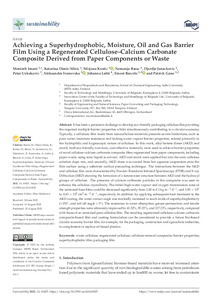Achieving a Superhydrophobic, Moisture, Oil and Gas Barrier Film Using a Regenerated Cellulose-Calcium Carbonate Composite Derived from Paper Components or Waste
Imani, Monireh; Dimic-Misic, Katarina; Kostic, Mirjana; Barac, Nemanja; Janackovic, Djordje; Uskokovic, Petar; Ivanovska, Aleksandra; Lahti, Johanna; Barcelo, Ernest; Gane, Patrick (2022-08)
Imani, Monireh
Dimic-Misic, Katarina
Kostic, Mirjana
Barac, Nemanja
Janackovic, Djordje
Uskokovic, Petar
Ivanovska, Aleksandra
Lahti, Johanna
Barcelo, Ernest
Gane, Patrick
08 / 2022
10425
Julkaisun pysyvä osoite on
https://urn.fi/URN:NBN:fi:tuni-202209056883
https://urn.fi/URN:NBN:fi:tuni-202209056883
Kuvaus
Peer reviewed
Tiivistelmä
It has been a persistent challenge to develop eco-friendly packaging cellulose film providing the required multiple barrier properties whilst simultaneously contributing to a circular economy. Typically, a cellulosic film made from nanocellulose materials presents severe limitations, such as poor water/moisture resistance and lacking water vapour barrier properties, related primarily to the hydrophilic and hygroscopic nature of cellulose. In this work, alkyl ketene dimer (AKD) and starch, both eco-friendly, non-toxic, cost-effective materials, were used to achieve barrier properties of novel cellulose-calcium carbonate composite films regenerated from paper components, including paper waste, using ionic liquid as solvent. AKD and starch were applied first into the ionic cellulose solution dope mix, and secondly, AKD alone was coated from hot aqueous suspension onto the film surface using a substrate surface precooling technique. The interactions between the AKD and cellulose film were characterised by Fourier-Transform Infrared Spectroscopy (FTIR) and X-ray Diffraction (XRD) showing the formation of a ketone ester structure between AKD and the hydroxyl groups of cellulose. The presence of calcium carbonate particles in the composite was seen to enhance the cellulose crystallinity. The initial high-water vapour and oxygen transmission rates of the untreated base films could be decreased significantly from 2.00 to 0.14 g m(-2) d(-1), and 3.85 x 10(2) to 0.45 x 10(2) cm(3) m(-2) d(-1), respectively. In addition, by applying subsequent heat treatment to the AKD coating, the water contact angle was markedly increased to reach levels of superhydrophobicity (>150 degrees, and roll-off angle < 5 degrees). The resistance to water absorption, grease-permeation, and tensile strength properties were ultimately improved by 41.52%, 95.33%, and 127.33%, respectively, compared with those of an untreated pure cellulose film. The resulting regenerated cellulose-calcium carbonate composite-based film and coating formulation can be considered to provide a future bio-based circular economy barrier film, for example, for the packaging, construction and agriculture industries, to complement or replace oil-based plastics.
Kokoelmat
- TUNICRIS-julkaisut [16977]
